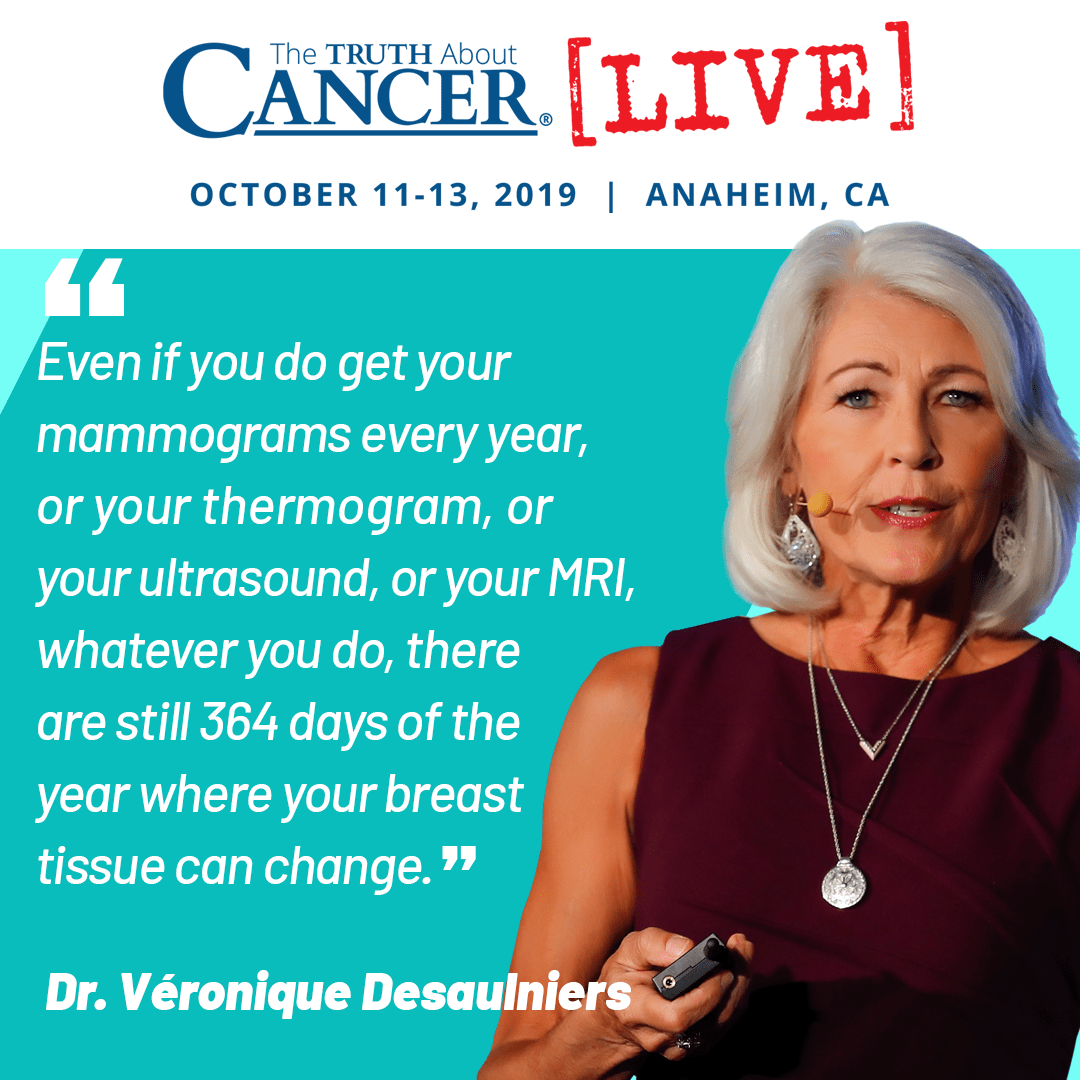Video Transcript – Dr. V’s 7 Essential Steps to Conquering Cancer (Part 2)
If you missed part 1, watch it here!
Thank you. So essential number five is biological dentistry. We all know that what’s in our mouth is going to affect our health. We know that mercury is a metalloestrogen, that it stimulates the growth of breast cancer. We know that root canals are toxic. We know when there is a toxic tooth that sits on a meridian that affects the breast, it’s going to have a direct relationship in weakening the energy flow to that organ. And so for me, essential number five, I did a 3D bone beam scan to see if I had cavitations, which I did. I didn’t realize I had. I had an autoimmune issue on tooth number 14, which I had no idea, which by the way, sat on the left breast meridian. My body attacked my tooth from the inside out. The dentist thought I had a little cavity there. When she went to drill it, my tooth was empty. So I had to address the autoimmune issue. I had to address the cavitations.
Essential number six is to repair your body with therapeutic plants and herbs. We can talk all day about the hundreds of evidence-based natural medicines that can weaken cancer cells and boost the immune system. For me, I chose to do the RGCC and followed the program with the natural extracts, lots of high dose vitamin C IVs, Poly-MVA IVs, all kinds of supplements, high dose proteolytic enzymes like Carol Alt talked about.
Essential number seven is to adopt very early detection. Now, this is a test that I encourage you to look at. It now has FDA clearance for early detection on four different types of cancers. Breast is one of them. When you’re in the green zone, that means you’re pretty much in the safe zone. So this was me last year. What this test looks at is free cancer DNA in the blood. If you’re in the red zone or the orange zone, that means you need to be more aggressive with your healing. This was an ultrasound that I had done at Hope4Cancer.
At one point I had four inflamed lymph nodes under my left armpit. Now doctors will tell you, “Get those cut out, the cancer’s spreading.” But did you know that studies show that, even when they cut those out, it does not affect mortality rate at all? There’s absolutely no benefit to having those removed, because what are the lymph nodes doing? They’re doing their job. When you get a sore throat, what happens? Your lymph nodes swell. They’re doing their job. When you have breast cancer, your lymph nodes are going to swell. They’re doing their job. My last scan showed that all the lymph nodes were clear except for one that had calcified, no longer active. I also had a test done called PTIS at Hope4Cancer, which is the little laser that’s inserted into the vein after you’ve taken a photosensitizer, and it measures real life circulating tumor cells in the blood. Last summer or last fall, zero, zip. And then all the other tests were coming back normal, nagalase, trifecta, thyroid, everything. Everything normal. So as of August of last year, after three years of intense journeying, I can now say again that I’m happy and very, very healthy. Thank you.
Alright. So as they’re trolling for business and telling women to go get a mammogram, they’re not giving you the big picture. After 25 year Canadian study and 90,000 women, they found that mammography did not reduce breast cancer mortality rate, not even by 1%. This used to be on the American Cancer Society’s website. They no longer have it. By the time breast cancer is seen on a mammogram, it’s been there for an average of six to eight years. And what happens when you get a mammogram? We know radiation causes cancer. Continuous radiation, low dose radiation can cause DNA damage. What about the compression? What if there’s a tiny little tumor in there and they compress it, and radiate it? That can spread malignant cells throughout your body. What about dense breasts? 50% of women now have dense breasts, and so 50% of the time, mammogram is going to miss a tumor because of the dense breast tissue. It’s a huge failure of mammography. Even if you do get your mammograms every year, or your thermogram, or your ultrasound, or your MRI, whatever you do, there are still 364 days of the year where your breast tissue can change.
According to the American Cancer Society, the most common symptom of a breast cancer is a lump or a mass. How many women here do breast exams on a regular basis? Do you know what you’re doing? Just kind of feel around, right? We’ve never been trained. Well, all that’s about to change. I’m going to introduce my breast friend. My breast friend is based on the MammaCare method, and this is the recognized gold standard that has trained physicians for over 30 years on how to do a clinical exam. It’s based on the MammaCare method and it was developed with the support of the National Cancer Institute and the National Science Foundation. So my breast friend is that silicone breast model. It’s a breast simulation model, and it teaches your fingers what to feel for. So in the model, which you’re looking at here, is four distinct lumps that are actual replicas of tumors that were removed from women’s breasts. It’s real life, nodular breast tissue. So when you do a proper breast exam, it’s going to teach you what to feel for, because you don’t know what a cancerous lump may feel like, right? This is going to show you the difference between your normal tissue and what a cancerous lump and may feel like. It teaches you where to feel. You don’t just poke around in your breast tissue, you have to go underneath your collarbone, armpit, sternum, underneath the breast. How to feel. Don’t use the tips of your fingers. You have to use the flats of your fingers, and you have to use the light, medium, and deep pressure all the way to the chest wall because sometimes tumors can hide all the way into the chest wall.
The average size lump that is found by a woman who’s not trained in a proper breast self-exam is the size of a ping pong ball. The average size lump that is found by a woman who’s trained in a proper breast self-exam based on the MamaCare method, is a size of a pea. And we know that size matters. When the cancer is small, when it’s less than a centimeter and it hasn’t spread yet, the patient’s 15 year survival rate exceeds 88%. So the good news is, eight out of 10 times when you find something suspicious, it’s not going to be cancerous. But if you find something suspicious, check with your doctor to make sure, and women are raving about this. We’re getting all kinds of feedback. It’s only been out since April, May and already women are saying, for example, this woman said, “My mom died of breast cancer. She was 55, so I ordered one for my sister and I. So we don’t have to go through that. So make sure that you take the time to examine your breast tissue every month. Very, very important. It can save your life. If you want more information, you want order a model, go to mybreastfriend.com and you’ll be able to learn more about it there. I want to talk about thermography. Thermography is not a standalone diagnostic tool. It’s not really a diagnostic tool, but it’s going to alert you of any types of physiological changes. Whether you choose to do a mammogram or a thermogram, don’t just do that. They’re not standalone. Use something to back it up. Do an ultrasound. Do your breast self-exam. We know the thermography can detect suspicious tissue when it’s the size of the tip of a needle, compared to a mammogram, which is going to find it many, many, many, many years later. So wouldn’t you want to have early detection at your fingertips?
So after all is said and done, do the 7 essentials work. So what you’re looking at here, are before and after thermograms of women that were our clients. The red means inflammation, increased blood flow, the blue and the green means healthier tissue. So there you see blood flow feeding a tumor, very similar to my situation before and after. You see the difference? Before and after, the red is inflammation, cancerous tissue after it’s clear. Before and after. Now that was me back in 2006. Big difference.



















I thank God for your insight and will share your experience and your wisdom with my readers at HideousHealthHabits.com I will of course, refer them to The Truth About Cancer as well.
Thank you so much, we appreciate your support.
Hi.
THANK YOU for doing God’s work!
I am looking for guidance and information on how to safely remove/cleanse silicone from my lymph nodes (I have 2 ruptured breast implants).
A bilateral ultrasound showed silicone in every lymph node scanned!
Doctor wants me to have an MRI w/contrast prior to having the implants removed.
I’m not sure where to go from here.
Thank you!
Bev Simon